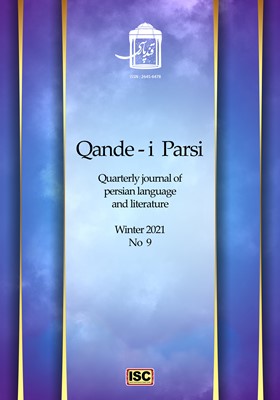A study of imagery innovation in Fazel Nazari poems based on natural images
Subject Areas : Analysis of order textssohila ebrahimzadeh 1 , razieh aqazadeh 2
1 -
2 -
Keywords: fazel nazari, poetic imagery, innovation, elements of nature,
Abstract :
Contemporary poets have been aware that art with initiative and innovation has a double emotional impact and imitation and repetition is the death of art. One of the components of poetry that is an arena for displaying innovation and provides an opportunity for the emergence of individual poetry of each poet the images are poetic and nature and natural elements are resources which has always been considered in poetic illustration. Fazel Nazari is one of the contemporary modernist poets which explores the natural elements to create new images by punctuation and narrow-mindedness and with an emphasis on personal perspective and climatic elements, creates amazing and unique images. Contemporary poets have been aware that art with innovation has a double emotional impact and imitation is the death of art. One of the components of poetry that is an arena for displaying innovation and provides an opportunity for the emergence of individual poetry of each poet the images are poetic and nature and natural elements are resources which has always been considered in poetic illustration. Fazel Nazari is one of the contemporary modernist poets which explores the natural elements to create new images by punctuation and narrow-mindedness and with an emphasis on personal perspective and climatic elements, creates amazing and unique images. In the present study, after studying the published works this poet it was found that Fazel is an illustrator poet. He with depth and accuracy discovers different features of a natural phenomenon, then he remembers and finds a connection between itself and those natural phenomena and with his artistic creativity, he creates a new image. Moon and Pond and Swamp, Waves, Rocks and Rivers, Pomegranate and Desert which is one of the climatic elements around it and … they are repetitive images which has been considered by this poet from various angles and are formed to express the poet's personal moods and emotions. Most of these images are in the form of similes and is of the sensible analogy to the sensible which is the most artistic type of simile. Along with many similes, simple metaphors and allusions and common Persian proverbs also have been employed.
1. امین پور، قیصر(1390)، مجموعه کامل اشعار، چ هفتم، تهران: انتشارات مروارید
2. علیمی، ماندانا و حسینی کازرونی، سید احمد(1395)، «بازنمایی تمثیل و نماد در گل و گیاه در دیوان صائب تبریزی»، فصلنامه تحقیقات تمثیلی در زبان و ادب فارسی، دوره8، شماره 28،تابستان 1395، صفحات83-102
3. برتنس، هانس(1394)، مبانی نظریه ادبی، ترجمه محمدرضا ابوالقاسمی،چ پنجم، تهران: نشر ماهی
4. بهمنی، محمدعلی(1377)، گاهی دلم برای خودم تنگ می شود، ج2، تهران: دارینوش
5. حافظ شیرازی، شمس الدین (1366)،دیوان غزلیّات، به کوشش خلیل خطیب رهبر، چ چهارم ، تهران: انتشارات صفی علیشاه
6. حریری،ناصر(1368)،درباره هنر و ادبیات،بابل:کتاب سرای بابل
7. دستغیب ، عبدالعلی(1385)، شاعر شکست ،تهران: آمیتیس
8. ریچاردز،آی.ا.(1379)، اصول نقد ادبی، ترجمه سعید حمیدیان، تهران، نشر مرکز
9. زرّینکوب، حمید (1367). مجموعه مقالات، چ 1، تهران: علمی و معین
10. شفیعی کدکنی، محمدرضا(1376)، آیینه ای بر ای صداها، چ اول،تهران، سخن
11. ________________(1384)، موسیقی شعر، چ هشتم، تهران: آگه
12. ________________(1392)، صور خیال در شعر فارسی،چ شانزدهم: تهارن: آگه
13. ________________(1366)؛ صور خيال در شعر فارسی، چ سوم، تهران : آگاه
14. شمیسا، سیروس(1373)، معانی و بیان2، چ چهارم، تهران: مرکز چاپ و انتشارات دانشگاه پیام نور
15. طباطبایی، سید مهدی (1393)، «بنمایة حباب و شبکة تصویرهای آن در غزلیّات عبدالقادر بیدل دهلوی»، مجله متنپژوهی ادبی، زمستان 1393، شماره62،صفحات81-123
16. فرخزاد، فروغ(1379)، دیوان اشعار،چ دوم، تهران: پل
17. فرشید ورد،خسرو (1373)، درباره ادبیات و نقد ادبی،تهران: انتشارات امیر کبیر
18. فلاح، غلامعلی، زارعی، مهرداد (1394)، «هندی وارگی در اشعار فاضل نظری»، مجله زبان و ادبیات فارسی (دانشگاه خوارزمی)، شماره 23( پیاپی78)، صفحات 166-146
19. کروچه، بندتو(1344)، کلیات زیباییشناسی، ترجمه فؤاد رحمانی، تهران: بنگاه ترجمه و نشرکتاب
20. نظری، فاضل(1388)، گریه های امپراتور، چ پنجم، تهران: انتشارات سوره مهر
21. ________(1393)، اقلیّت، چ بست و هفتم، تهران: انتشارات سوره مهر
22. ________(1398)، ضد، چ چهل و دوم، تهران: انتشارات سوره مهر
23. ________(1398)، کتاب، چ سی ام، تهران: انتشارات سوره مهر
24. ________(1398)،آنها، چ پنجاه و یکم، تهران: انتشارات سوره مهر
25. نیمایوشیج (1385)، درباره هنر شعر و شاعری ، تهران: انتشارات نگاه


